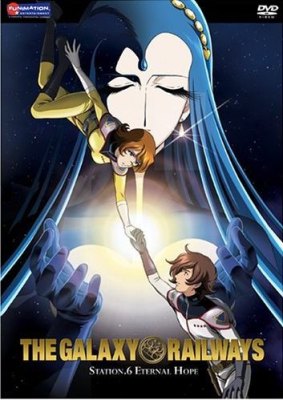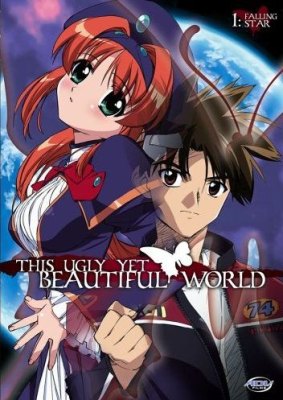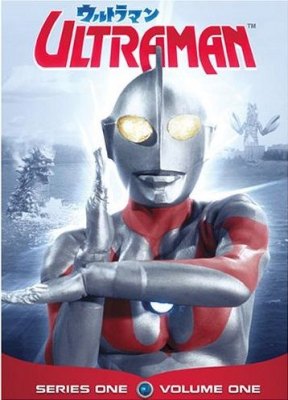
 |
|
| |||||||||||||||||||||||||||||||||||||||||||||||||||||||||||||||||||||||||||||||||||||||||
|
Ultraman, Naruto Uncut
AnimeTalk a bi-weekly column by Don Houston, John Sinnott, and Todd Douglass Some great anime discs have recently been released and
Anime Talk covers the cream of the crop. Galaxy
Railways, a series created in honor of the
50th anniversary of influential comic artist Leiji Matsumoto's first
published work, wraps up with volume six ans the utra-popular series
Naruto is finally released uncut. We also have a review of BCI's
release of the first Ultraman
series. While this remastered set still has some problems, fans
will want to at least check the discs out for themselves. There's
also Holly's Anime Bargains,
our table of upcoming anime discs and a lot
more. The Latest Anime Reviews:
 Volume six of Galaxy Railways
wraps up the series, and it sure ends with a bang. Things are
looking bleak for the SDF and Sirius Platoon. With Captain Bulge
relieved of his command, Sirius Platoon disbanded, and the seemingly
invincible Alfort Fleet attacking, it seems that there's no hope for
planet Destiny. This volume ends the series on a
high note. One of the better conclusions to an anime series this
disc wraps up the story in a very satisfying way that will keep viewers
on the edge of their seats. A solid series all the way along,
this final volume really pays off. It is Highly Recommended. Volume six of Galaxy Railways
wraps up the series, and it sure ends with a bang. Things are
looking bleak for the SDF and Sirius Platoon. With Captain Bulge
relieved of his command, Sirius Platoon disbanded, and the seemingly
invincible Alfort Fleet attacking, it seems that there's no hope for
planet Destiny. This volume ends the series on a
high note. One of the better conclusions to an anime series this
disc wraps up the story in a very satisfying way that will keep viewers
on the edge of their seats. A solid series all the way along,
this final volume really pays off. It is Highly Recommended.Godannar is almost over and only one more volume remains. In the meantime fans will want to sink their teeth into the sixth installment for more mimetic beast action. Goh has been grounded due to his Insania Virus infection and Shizuru is called upon to take his place at the helm of Godannar. In the meantime Ken and Lou show up to fight a big mama of a monster that comes out of nowhere. Shortly thereafter all hell breaks loose as Ken loses control of himself and a barrage of mimetic activity hits Dannar bases around the world. The story is getting a little more interesting after the lull about midway through the show but will things end the way we want them to? The latest volume of Fighting Spirit, the twelfth in the series, is just as good as the previous eleven. This sleeper hit started strong and continues to deliver as this volume illustrates. In this disc, Ippo finally has his chance at a national title. All his has to do is defeat the current champion, which is much easier said than done. The aftermath of the fight effects the young boxer much more than he had anticipated. Thsis is a fun series with a lot of drama and excitement, and it's really easy to get to like Ippo, the underdog who advances through hard work and an overwhelming desire to win.  This Ugly Yet
Beautiful World is a new
series by ADV that has a lot of potential. Unfortunately that potential
hasn't
been realized yet and with only nine episodes remaining this half
season anime
seems to be taking its sweet time. The first episode was amazing and
offered a
fresh and energetic spin on a tried and true concept. What followed in
the next
three episodes was a slowly paced mess of harem comedy and raunchy
situations.
The potential is there, but in this first volume the only one that taps
into it
is the premiere episode which leaves the rest of this release feeling
like a
disappointment. This Ugly Yet
Beautiful World is a new
series by ADV that has a lot of potential. Unfortunately that potential
hasn't
been realized yet and with only nine episodes remaining this half
season anime
seems to be taking its sweet time. The first episode was amazing and
offered a
fresh and energetic spin on a tried and true concept. What followed in
the next
three episodes was a slowly paced mess of harem comedy and raunchy
situations.
The potential is there, but in this first volume the only one that taps
into it
is the premiere episode which leaves the rest of this release feeling
like a
disappointment.Animation Runner Kuromi 2, as you might surmise from the name, is an OVA sequel to the 2001 release Animation Runner Kuromi. A light look at the inner workings of an anime studio, this show has a lot of laughs, especially if you're familar with the way animation is created in Japan. If you don't know what a key cell is, or what a director actually does, some of the humor might be lost. I have never seen an OVA quite like the one made for Saikano back in 2005. Three years after the series its creators decided to go back in and fill some off camera gaps. If you watched the show then you know all about what happened to Chise but if you were ever wondering what was going on behind the scenes at the military; here are your answers. The two episodes here follow the activities of Chise's mentor and predecessor, Mizuki, as she goes through kind of the same relationship drama that her younger counterpart did. The story is good and worthwhile for fans of the show although this is something we've been through before.  Arguably the most popular manga in the world right now, Naruto has
finally received some appropriate loving from
Viz. If you heard about the edited release of this show and were
holding off
you'll be very pleased to know that an uncut boxed set comprised of the
first
thirteen episodes has just been released. Often compared to Dragon
Ball this series follows the exploits of a young ninja who is
the
unwitting host of a great fox demon. Naruto lives in the Arguably the most popular manga in the world right now, Naruto has
finally received some appropriate loving from
Viz. If you heard about the edited release of this show and were
holding off
you'll be very pleased to know that an uncut boxed set comprised of the
first
thirteen episodes has just been released. Often compared to Dragon
Ball this series follows the exploits of a young ninja who is
the
unwitting host of a great fox demon. Naruto lives in the With volume seven of Kyo Kara Maoh, the series continues to become a darker and more serious show, something that was started in volume six. Things start to come to a head as the human country of Big Cimaron raises an army of slaves and indentured servants that they hope will wipe out the demon tribe once and for all. Not only that, but they've obtained a mystical weapon that will surely tip the scales in their favor. Trapped behind enemy lines, Yuri has to get back to the demon kingdom with the information that he's learned, but with an entire army looking for him, it won't be easy. Be sure to take a look at recommendations by DVDTalk's twisted cast of reviewers in their Best Of Anime 2003, Best Of Anime 2004, and Top Ten Anime discs of 2005 articles.
Scheduled for release on August 8th,
2006
Amazon Slick Catch:
Best Prices Awesome Grab:
Buy Mecha Deal:
DVD Empire Raid:
by John Sinnott  Ultraman: Series One, Vol. 1 When I was in Japan on business a few years ago, my host asked me if I wanted to shop for any souvenirs before I returned to the states. I told him that I did, and that my sons would really like some Japanese toys based on their favorite anime at the time Tenchi Muyo. None of the people I was working with had ever heard of the show, nor any of the other anime that I rattled off. Undaunted, they gave me directions to a toy store where I found some Dragon Ball Z figures, a couple of Super Sentai items, and an nice assortment of Ultraman toys. Returning to the offices after lunch, everyone wanted to see what I had purchased. The feigned interest in most of the toys, but when I pulled out the Ultraman figures, their eyes lit up and they all started commenting on the toys. "That's the best Ultraman, he was the strongest!" "Oh, those two are brothers." "Do you remember that monster? He could turn invisible." This group of professors and engineers had instantly reverted to childhood, telling me the history and powers of each of the Ultraman heroes and monsters that I had purchased.
Ultraman is imbedded in Japanese culture. There really isn't an equivalent show or event here in the States. In Japan, Ultraman, in one incarnation or another, has been broadcast (on and off) since his first appearance in 1966. Though he was largely absent during the 1980's, the series is still going strong. There are Ultraman toys, apparel and knick-knacks still being produced today. It's a cultural phenomenon that has lasted over a generation. After a long and protracted legal battle,
the first Ultraman series1 has
been released here in the US by BCI. Featuring the first half of the
first season, this set of 20 episodes not only has Ultraman's first
appearance as well as some of his most famous enemies, but it has also
been remastered. Unfortunately, the audio and video
The creative force behind Ultraman was Eiji Tsuburaya. He's known for creating the special effects for the original Godzilla films and in 1963 he established his own company, Tsuburaya Productions, so he could apply his expertise to TV shows. The first show that they produced was Ultra Q (1966), a series featuring a group that investigated strange phenomena including giant monsters, aliens and the like. This only lasted one season, but the week after its final episode was broadcast Tsuburaya Productions had another show on the air: Ultraman. This show was a huge hit, grabbing the public's imagination, spawning a slew of imitators and it was also one of the first Japanese shows to get wide distribution throughout the world. In the near future, the Science Patrol guards Japan from dangers originating from Earth and outer space with their high tech weaponry. While investigating a strange phenomena, Patrol member Shin Hayata's plane is destroyed by a giant red ball of light and he is mortally injured. This glowing phenomenon was actually Ultraman's space ship. A police officer from Nebula M78, Ultraman was taking the monster Bemler to prison when it escaped and headed towards Earth. Not wanting to be responsible for Hayata's death, Ultraman gives the young officer his life force. The giant alien will now share a body with Hayata, and gives him a mysterious device called a 'beta capsule.'
When the button on the beta capsule is pressed, Hayata becomes Ultraman. 200 feet tall and endowed with amazing powers, this silver and red warrior on the side of good battles the creatures that attempt to invade Japan. Though Ultraman is powerful, he does have a weakness. The Earth's atmosphere filters out the solar energy that powers Ultraman. Because of that, Ultraman can only exist for three minutes at a time on the planet. On his chest is a Color Timer that measures the amount of time he has left. It starts off blue, but after a minute the timer starts to blink. At the two minute mark the Color Timer turns red and starts to blink faster. If it ever stops, Ultraman "will never rise again." This adds a nice dash of excitement to the battles. When the Color Timer starts blinking red, you know the giant fighter has to win quickly or run away. In addition to Hayata, the Science Patrol consists of Captain Toshio Muramatsu who leads the group, Daisuke Arashi the marksman, Mitsuhiro Ide (or Ito in the English dub) who acts as the comic relief, and Akiko Fuji, the token female who usually stays behind to operate the radio. In addition to these is Fuji's friend, 11-year-old Hoshino who is always hanging around the SP offices and often gets in trouble though no one ever tells him to go home.
The episodes themselves are fairly formulistic, though that doesn't mean they aren't enjoyable. A monster surfaces, the Science Patrol attempts to defeat it with limited results, then Hayata runs off and becomes Ultraman to finally defeat the nemesis. It's easy to see why this show became so popular though. The half-hour format is just the right amount of time for the show. There's enough room to establish the nature of the menace and where it came from, create a small plot concerning members of the Science Patrol, and then have a good battle. The show doesn't get tied down with too much plot the way some Godzilla movies do, and the fight scenes aren't so long that they get monotonous. It's a very nice balance. Another strong point is the creative monster designs that are used throughout the series. Yes, they are all played by men in rubber suits, but Tsuburaya Productions created some very interesting and fun monsters. From the Jiraasu which is a repainted Godzilla with a giant lettuce leaf around his neck to the popular Red King and armor plated uranium-eating Gabora the monsters are always a fun part of the show.
Even though it is a bit hokey in parts, the special effects aren't that great and the dialog is laughable at times I really had a lot of fun watching this show. It has a lot of charm and more than a little action. A great program that brings back a lot of fond memories. The DVD: The twenty episodes in this set come on three single sided DVDs enclosed in thinpak cases and housed in a colorful slipcase. There is an informative 8 page booklet with episodes synopses and an essay about Ultraman packed in the set too. The set was advertised to have two trading cards included, but the set that I received, with was in retail packaging, did not have them.
Video: On the back of this set the advertising touts that these shows have been "newly remastered with stereo sound and brilliant color." This is no doubt true, and at first glance the full frame color image look much, much better than the bootlegs that have been sold at comic conventions and on the internet for years. The image is clear and the detail is very good. There are very few print defects, with dirt and scratches being very rare. That's the good news. The bad news is that it looks like they digitally brightened the colors. The colors are strong and bright, one of the first things that viewers will notice about the prints, but they don't look natural. It looks more like a colorized black and white movie than something that was filmed in color. Skin tones are particularly problematic, with people looking like wax dummies rather than living people. There's also an unusual amount of color bleeding. Reds and blues are the most noticeable, but even the pink of people's faces will bleed into the adjoining images. There are other digital defects also. Pixalation pops up in several episodes, especially in action sequences and aliasing is fairly common too. Another problem with this set is that the closing credits are totally missing. When an episode ends, it just cuts to black with no credits or ending song. This is surely because BCI did not have access to the original prints or negatives for this remastered set.2 While this does look better than any of the illegal versions that I have seen, I was disappointed with the overall look of this set. Audio: I was very disappointed in the audio quality of this set too. The original Japanese track and the English dub leave a lot ot be desired. The Japanese audio is so bad that it's hard to listen to. There is a lot of distortion, even people's voices talking at normal levels distorts heavily. This is the worst audio I've heard on a release from a reputable studio. The English track isn't much better. There is a hum that is fairly loud throughout the show which is rather irritating, and pops and other noise are fairly common. The audio is also very flat with very little range. Though the dialog is easy to hear, but that's about the best you can say about it. That's not all though. The English dialog track with spontaneously revert to Japanese (with subtitles) on some episodes. Someone from BCI has stated that they received incomplete dub tracks for the episodes, and this was the best they could come up with. In any case these sections don't last for long. There are optional subtitles in English, which could stand to be proof read by a native English speaker. Extras:
There is also the American version of the opening credits and a series of text monster profiles. Final Thoughts:
1) The first 'ultra' series was Ultra Q broadcast in 1966. Though it has 'ultra' in the title, there were no 'ultra' beings in the show. 2) This series has been
tied up in court for years. Tsuburaya Productions owns the rights to Ultraman,
but a company from Thailand, Chaiyo Productions, claimed that they held
the international rights to the show. They produced a contract that the
late Noboru Tsuburaya, Eiji's son, stamped in 1976 which gave the
rights to Ultraman outside of Japan to Chaiyo. This was
supposedly done in exchange for a personal loan. There were several odd
things about the contract, including incorrectly naming various Ultraman
series, so Tsuburaya Productions executives claimed that it was a fake.
After a long legal battle, Chaiyo was awarded the international rights,
and it was from this company that BCI signed a contract with.
Naturally, Tsuburaya Productions was not about to lend out the original
elements to the show when they feel they've been swindled out of a very
lucrative license.
Archives
January 2015 Edition
2013 Q4 Top Anime Titles from RightStuf.com, Part 1 Holiday Edition Crunchy Roll, Lupin, and Bunny Drop Compete Archives
Review Staff
| Newsletter Subscribe
| Join DVD Talk Forum
|
| |||||||||||||||||||||||||||||||||||||||||||||||||||||||||||||||||||||||||||||||||||||||
| |||||||||||||||||||||||||||||||||||||||||||||||||||||||||||||||||||||||||||||||||||||||||